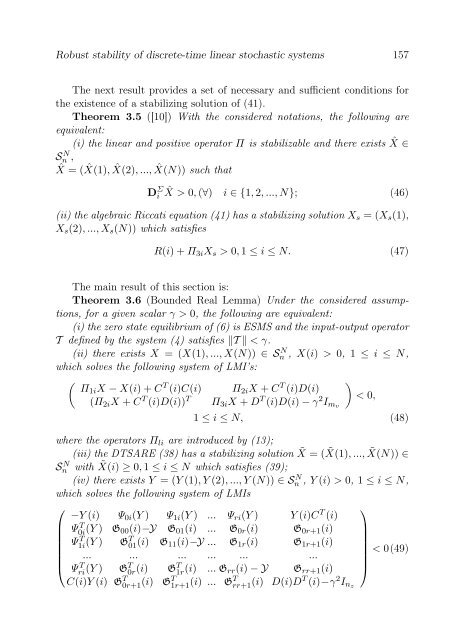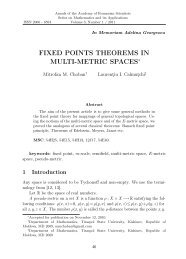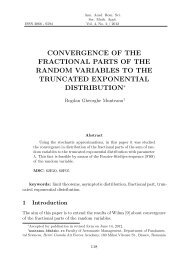Articles - Mathematics and its Applications
Articles - Mathematics and its Applications
Articles - Mathematics and its Applications
Create successful ePaper yourself
Turn your PDF publications into a flip-book with our unique Google optimized e-Paper software.
Robust stability of discrete-time linear stochastic systems 157The next result provides a set of necessary <strong>and</strong> sufficient conditions forthe existence of a stabilizing solution of (41).Theorem 3.5 ([10]) With the considered notations, the following areequivalent:(i) the linear <strong>and</strong> positive operator Π is stabilizable <strong>and</strong> there exists ˆX ∈S N n ,ˆX = ( ˆX(1), ˆX(2), ..., ˆX(N)) such thatD Σ iˆX > 0, (∀) i ∈ {1, 2, ..., N}; (46)(ii) the algebraic Riccati equation (41) has a stabilizing solution X s = (X s (1),X s (2), ..., X s (N)) which satisfiesR(i) + Π 3i X s > 0, 1 ≤ i ≤ N. (47)The main result of this section is:Theorem 3.6 (Bounded Real Lemma) Under the considered assumptions,for a given scalar γ > 0, the following are equivalent:(i) the zero state equilibrium of (6) is ESMS <strong>and</strong> the input-output operatorT defined by the system (4) satisfies ‖T ‖ < γ.(ii) there exists X = (X(1), ..., X(N)) ∈ Sn N , X(i) > 0, 1 ≤ i ≤ N,which solves the following system of LMI’s:(Π1i X − X(i) + C T (i)C(i) Π 2i X + C T )(i)D(i)(Π 2i X + C T (i)D(i)) T Π 3i X + D T (i)D(i) − γ 2 < 0,I mv1 ≤ i ≤ N, (48)where the operators Π li are introduced by (13);(iii) the DTSARE (38) has a stabilizing solution ˜X = ( ˜X(1), ..., ˜X(N)) ∈Sn N with ˜X(i) ≥ 0, 1 ≤ i ≤ N which satisfies (39);(iv) there exists Y = (Y (1), Y (2), ..., Y (N)) ∈ Sn N , Y (i) > 0, 1 ≤ i ≤ N,which solves the following system of LMIs⎛−Y (i) Ψ 0i (Y ) Ψ 1i (Y ) ... Ψ ri (Y ) Y (i)C T ⎞(i)Ψ0i T (Y ) G 00(i)−Y G 01 (i) ... G 0r (i) G 0r+1 (i)Ψ1i T (Y ) GT 01 (i) G 11(i)−Y ... G 1r (i) G 1r+1 (i)⎜ ... ... ... ... ... ...< 0(49)⎝ Ψri T (Y ) GT 0r (i) GT 1r (i) ... G ⎟rr(i) − Y G rr+1 (i) ⎠C(i)Y (i) G T 0r+1 (i) GT 1r+1 (i) ... GT rr+1 (i) D(i)DT (i)−γ 2 I nz






